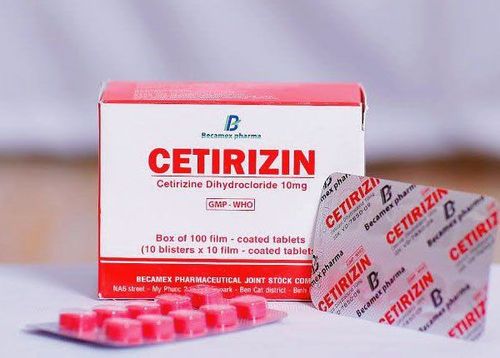This is an automatically translated article.
Children 3 years old, children 4 years old with urticaria also have symptoms like adults, but the disease can be more persistent, causing children to cry, stop eating and affect their lives. Parents need to understand the cause of the child's urticaria, to handle it properly and promptly, to help the child stop being uncomfortable.1. What is urticaria?
Hives, also known as urticaria, are areas of swelling on the skin that often cause itching. They can appear in different shapes and sizes, but are usually well defined, with a pale, raised area surrounded by a red border.Urticaria is common, but not contagious. They usually last for a few hours or days, but can also last for months. Hives can occur in any area of the skin in a 3-year-old or 4-year-old child, or they tend to appear in certain areas of the body.
This dermatological disease is common in infants and young children, because their bodies are still immature and their immune systems are not fully developed.

Nổi mề đay, còn được gọi là mày đay, là những vùng sưng tấy trên da, thường gây ngứa
2. Causes of hives in children
Hives occur when the body releases a chemical called histamine. There are many reasons for hives that make it difficult to pinpoint the exact factor. Most likely due to:Insect bites and stings For example, if a child is allergic to bees or fire ants, they may develop hives when bitten by these animals.
Food Children get hives in response to foods, such as milk, eggs, peanuts, nuts (almonds, walnuts, pecans), soybeans, wheat, fish and seafood ... Certain food additives and preservatives can also cause hives. Children may develop hives due to an allergy to a food protein or simply because the body releases histamine in response to a chemical in the food. Some babies even develop hives even when exposed to food alone - for example, when strawberry juice gets on their baby's skin.
Allergens Children who are allergic to cats may develop hives when touched by cats. Your child may even have a hives reaction to an airborne allergen, such as pollen.
Sick 3-year-old has hives when he has a cold or a viral infection. Less commonly, babies also develop hives when they have a bacterial infection.
Temperature Sometimes cold temperatures cause hives. The same goes for sudden temperature changes - for example, when a baby's skin heats up quickly after being cold.
Medicines Antibiotics and some other medicines can also cause hives in children.
For each cause, there will be a corresponding remedy, but according to statistics, up to 50% of children have urticaria of unknown cause, also known as idiopathic urticaria.

Một số loại thuốc có thể khiến trẻ bị nổi mề đay
3. Treatment of urticaria
Children's skin is especially sensitive, so treatment should be done with extreme caution. Here are some healthy and safe steps you can take:If you think your child's hives are caused by a pet or pollen allergy, give him a bath to wash off the allergen thoroughly. the better. Sometimes cool compresses and cool baths also help relieve itching and discomfort. You can also try applying calamine lotion to a cotton ball and dabbing it on your child's hives. Avoid letting your child wear tight clothing to the area affected by the urticaria. If hives are bothering your child, ask your child's doctor if an appropriate dose of antihistamine can be given to reduce itching and swelling.

Nếu nổi mề đay khiến con bạn khó chịu, hãy hỏi bác sĩ xem có thể cho trẻ uống thuốc kháng histamin với liều lượng thích hợp
4. When to see a doctor?
Call 911 right away if your child has respiratory symptoms - like wheezing or difficulty breathing, a swollen face or tongue, or fainting. Along with hives, these symptoms could signal anaphylaxis - a serious, potentially fatal allergic reaction. Children's respiratory system is very small, so even a little swelling makes it very difficult for the baby to breathe.If an antihistamine is given and your child is still not comfortable or if it is making her too drowsy, ask your doctor about other options. Sometimes, your doctor will prescribe steroids, such as prednisone, to treat hives that don't respond to antihistamines.
Even if your child doesn't seem uncomfortable despite the hives, it's still important to take him to the doctor if the rash doesn't go away after more than a week.
At Vinmec International General Hospital, there is a package of examination and advice on treatment of atopic dermatitis to help customers assess the overall condition of the disease and advise on measures to help prevent recurrence.
When registering for a package of examination and consultation for treatment of atopic dermatitis, customers will receive: Dermatology specialist examination. Perform tests such as: quantitative IgE, fresh mycobacteria, specific IgE quantification with respiratory allergens - food (Panel 1 Viet), test Rida Allergy Screen (panel 1)...
If you have a need for medical examination at Vimec Health System nationwide, please make an appointment on the website to be served.













